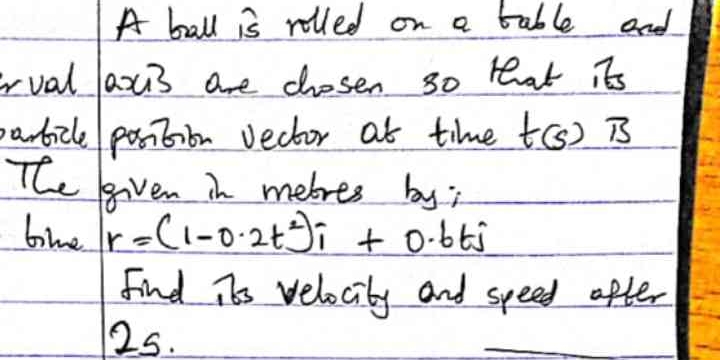A ball is rolled on a table and its position vector at time t(s) is given in meters by r = (1 - 0.2t^2)i + 0.6tj. Find its velocity and speed after 2.5 seconds.

Understand the Problem
The question is asking for the velocity and speed of a ball at a specific time based on its position vector given in the problem.
Answer
The velocity is $\mathbf{v}(2.5) = -1.0 \mathbf{i} + 0.6 \mathbf{j}$ m/s, and the speed is approximately $1.166$ m/s.
Answer for screen readers
The velocity of the ball after 2.5 seconds is $\mathbf{v}(2.5) = -1.0 \mathbf{i} + 0.6 \mathbf{j}$ m/s, and its speed is approximately $1.166$ m/s.
Steps to Solve
-
Identify the Position Vector The position vector of the ball is given by $$ \mathbf{r}(t) = (1 - 0.2t^2) \mathbf{i} + 0.6t \mathbf{j} $$
-
Differentiate to Find Velocity To find the velocity vector $\mathbf{v}(t)$, we differentiate the position vector with respect to time $t$: $$ \mathbf{v}(t) = \frac{d\mathbf{r}}{dt} = \left(\frac{d}{dt}(1 - 0.2t^2)\right) \mathbf{i} + \left(\frac{d}{dt}(0.6t)\right) \mathbf{j} $$
-
Calculate the Derivative Components Calculating the derivatives gives: $$ \mathbf{v}(t) = (-0.4t) \mathbf{i} + 0.6 \mathbf{j} $$
-
Evaluate the Velocity at $t = 2.5$ seconds Now, substitute $t = 2.5$ into the velocity vector: $$ \mathbf{v}(2.5) = (-0.4 \cdot 2.5) \mathbf{i} + 0.6 \mathbf{j} $$ Calculate: $$ \mathbf{v}(2.5) = -1.0 \mathbf{i} + 0.6 \mathbf{j} $$
-
Calculate the Speed The speed is the magnitude of the velocity vector: $$ \text{Speed} = |\mathbf{v}(2.5)| = \sqrt{(-1.0)^2 + (0.6)^2} $$
-
Compute the Magnitude Calculating the speed gives: $$ \text{Speed} = \sqrt{1 + 0.36} = \sqrt{1.36} \approx 1.166 $$
The velocity of the ball after 2.5 seconds is $\mathbf{v}(2.5) = -1.0 \mathbf{i} + 0.6 \mathbf{j}$ m/s, and its speed is approximately $1.166$ m/s.
More Information
The velocity vector indicates the direction and magnitude of the ball's motion at the specified time. The speed is a scalar quantity representing how fast the ball is moving regardless of direction.
Tips
- Forgetting to differentiate both components of the position vector.
- Miscalculating the magnitude of the velocity vector, especially when squaring components.
AI-generated content may contain errors. Please verify critical information